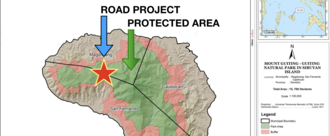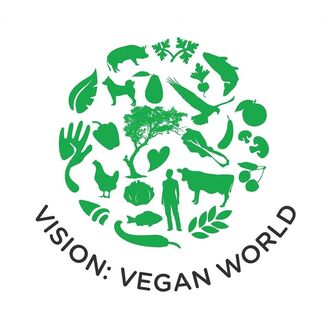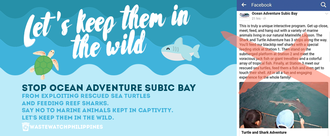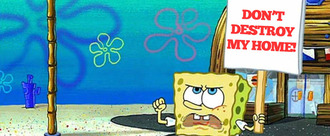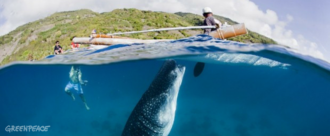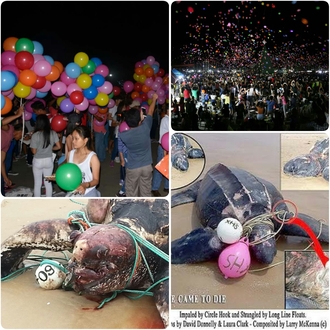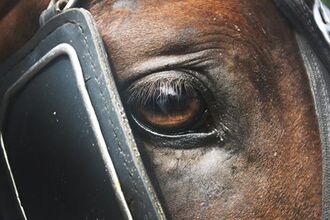-
STOP NATIONAL ROAD CONSTRUCTION AT MT. GUITING-GUITING NATURAL PARK (SIBUYAN ISLAND, ROMBLON)Remember that Mt. Guiting-guiting is Sibuyanon’s remaining terrestrial life-support system. If we attempt to destruct its ecological balance without proper scientific and sociological bases under the principles of sustainable development, we will all suffer the consequences. At the heart of Sibuyan Island is the Mt Guiting-Guiting Natural Park (MGGNP). It is the only remaining mountain in the Philippines with relatively intact habitats along its entire elevational gradient. Mt. Guiting-Guiting’s plant and mammal biodiversity is amongst the richest in the world (Heaney and Regalado 1998, Goodman and Ingle 1997, DENR 1997) Be it known that Bayay Sibuyanon and those who seek the stoppage and investigation of this project are not against development but shall continue to promote and adhere to the targets and indicators of Sustainable Development Goals (SDGs). Sustainable development and precautionary principles must always be considered in implementing projects in ecologically sensitive and disaster prone areas. The ‘Priority Sites for Conservation in the Philippines: Key Biodiversity Areas’ document by the Protected Areas and Wildlife Bureau (PAWB), now BMB, of the Department of Environment and Natural Resources (DENR) exposes that there are one critically endangered, four endangered, and eight vulnerable species of biodiversity in Mt. Guiting-guiting Natural Park, which includes the endangered Philippine tube-nosed fruit bat, Nyctimene rabori, and a vulnerable Sibuyan pitcher plant, Nepenthes sibuyanensis. The project is not included in the Mt. Guiting-guiting Natural Park Management Plan. Almost every year, new biological species are being discovered. In 2008, a new species of stick insect has been discovered, the Pharnacia magdiwang. In 2010, a new species of shrew has been documented, Crocidura ninoyi. Gekko coi or Leonard’s Forest Gecko, named after famous taxonomist Leonardo Co, was known in 2011. And in 2012, a new owl species has been found, Ninox hilippensis spilonota; in 2014 a pitcher plant named after a Sibuyanon slain environmentalist Armin Marin, Nepenthes armin. In the same year, a rare endemic species of a tree skink Lipinia vulcania was recorded and a new species of lizard called Pseudogekko isapa sp. The Department of Environment and Natural Resources describes Sibuyan Island having "relatively rich biodiversity": "There are approximately 700 vascular plant species, including 54 species that are endemic to the island. These include Nepenthes sibuyanensis J Nerz (Sibuyan Pitcher Plant); Heterospathe sibuyanensis Becc. (Bil-is), Pinanga sibuyanensis Becc. (Tibañgan), and Orania palindan var. sibuyanensis, a wild palm; Alpinia sibuyanensis, Phyllanthus sibuyanensis, Cyathea sibuyanensis Copel. (Tree Fern); Agamyla sibuyanensis Hilliard & BL Burtt (Sibuyan lipstick plant); Myrmephytum beccarii Elmer (Sibuyan ant plant); Begonia gitingensis Elmer (Guiting-guiting begonia). Of the 700 plant species in the Island, 180 species can only be found in the Philippine archipelago. There are numerous endemic species in Mt. Guiting-Guiting that occupy specific habitats. These are found mostly in primary forest with elevation of 100 meters or higher (Madulid, Domingo, 1997). The endemic species found in the protected area are as follows: • Sararanga philippinensis grows gregariously and form distinct clumps in Peat swamp forest along riverine/riparian forest at low altitudes. • Heterospathe sibuyanensis and Ardisia sibuyanensis located in primary forest at medium altitudes; and • Nepenthes merrillii and Alpinia sibuyanensis most of these are found in primary forest between 100 and higher elevations. A total of 130 species of birds have been recorded in Sibuyan, of which 102 are either known or presumed to be breeding residents. These are: Cinnamon Bittern-Lapay (Ixobrychus cinnamomeus), Celestial Monarch (Hyphothymis coelestis), Striated Grassbird (Megalurus palustris forbesi), Rufous –lored Kingfisher (Halcyon winchelli nesydrionetes), Pygmy Swiftlet (Collocalia troglodytes), and Philippine Hawk-Eagle (Spizaetus philippensis). Sibuyan is also home to nine (9) native non-flying terrestrial mammal species, four (4) of which are endemic rodents (Goodman and Ingle, 1993). This are: Greater Sibuyan forest mouse (Apomys sp. B), Lesser Sibuyan forest mouse (Apomys sp. C), Sibuyan striped shrew-rat (Chrotomys sp. A), and Sibuyan giant moss mouse (Tarsomys sp. A) . Out of nine fruit bat species found in the island, only one (1) species, Sibuyan Pygmy fruit bat (Haplonycteris sp. A) is endemic (Goodman & Ingle, 1993). Dugongs (Dugong dugong) have also been sighted within the municipal waters and dolphins and whales are also expected to be visiting the area. There are nine (9) recorded species of lizards and geckoes two (2) which are classified as endemic and rare. Gekko romblon, the Romblon narrow-disked Gecko, appears to be limited to Tablas and Sibuyan Island."586 of 600 SignaturesCreated by Bayay Sibuyanon Inc. Romblon, Philippines

-
Everybody has a Right to Compassionate, Plant-based/Vegan Food, Give us Access to it!There is a growing number of people all over the world, and in the Philippines who are shifting to a vegan diet and lifestyle. It is a conscious choice to show love and respect for animals and Mother Earth, and to care for one's own health and well-being. People like these should not be marginalized by having practically nothing to choose from in school, office, and hospital canteens, restaurants, hotels, and other food establishments. There are a number of vegan groups on Facebook in the Philippines, such as Vegan Philippines, Manila Vegans, Vegans of Manila, among many others. These are proof that there is a growing interest in a vegan diet in the country. The members of these groups are vegans, transitioning, or vegan-curious. Aside from the people who are in vegan groups, there are countless others who prefer healthier, more ethical, and more environment-friendly food choices. There are so many reasons why a vegan diet is becoming the food choice of many: 1. COVID-19 is one of the many zoonotic diseases that have caused a lot of death and suffering in the Philippines and the rest of the world. There are also other emerging diseases from animals that could cause another pandemic such as various strains of the swine flu virus and the bubonic plague. There is no better time than now to support and promote plant-based/vegan food in the country to build health and immunity, and to prevent another pandemic from emerging. 2. Compassionate/Vegan food is an ethical choice as it does not use any animal ingredients that cause needless suffering and death to animals. Animals are sentient beings that should not suffer and die for people's taste buds. Everyone could thrive on a balanced vegan diet. There is no need to kill animals for food. See the documentary Earthlings for more information. 3. Vegan food is better for the climate. With worsening climate change, shifting to vegan food drastically reduces one's carbon footprint. A meat-based diet has been found to generate more carbon pollution than the entire transport sector. An Oxford University study found that meat-based diets result in 7.2 kg carbon emissions a day, while only 2.9 kg for a vegan diet. Recently, the DENR started promoting a plant-based to help address climate change. Also, see the documentary Cowspiracy for a better understanding of this. 4. Vegan food is kinder to Mother Earth. With the antibiotic-laden animal waste being generated by the poultry and livestock industry, so much soil and water are being polluted every single day. Livestock is fed with corn, soybeans, and grains, which require a huge amount of fertilizers and pesticides. There is also an inefficient conversion of calories of crops for food converted to animal feeds. More people would be fed by directly using grains for food than if they were converted to animal feeds. 5. Vegan food is healthier. Whole foods, fresh fruits, and vegetables are more alkaline and thus prevent many types of illnesses. Studies have shown that blood from vegans fight off cancer cells. There are also numerous studies showing vegans have a lower risk of cancer, as well as lower rates of diet-related diseases such as obesity, diabetes, and hypertension. Canada has revised their dietary guidelines with much emphasis on plant-based food. For more information on health benefits of a plant-based diet, see the documentary What the Health. People who make an effort to make conscious choices for animals, for their health, and for the planet should be provided access to these kinds of food. By providing compassionate food choices, it could also make businesses thrive. Owners of vegan restaurants and shops claim most of their customers are not even vegan but vegan-curious, who are more than happy to try healthier, more earth-friendly, and ethical food choices. This means that given alternatives, more people would start to choose better. Even non-vegans deserve to have a choice when they want to try healthier, more ethical alternatives. Vegans would like to alleviate the needless suffering and death of animals and in the process also protect the earth, the climate, and themselves. Why should hotels, restaurants, canteens, and grocers not provide vegan choices to them? In fact, everybody should have access to vegan food. The future is vegan, let us create it now by supporting and promoting vegan food.429 of 500 SignaturesCreated by Shiela R Castillo

-
Keep Them in the Wild: Turtle and Shark Adventure ( Ocean Adventure Subic Bay)Since 2014, 5 false killer whales, 6 bottlenose dolphins, and 1 sea lion, have died in captivity in one marine park alone in the Philippines. There could be more unrecorded deaths since then in other marine park establishments. The attractions of Ocean Adventure Subic Bay harm marine life and do not teach people about the protection of marine animals. Moreover, it should be established that holding, grabbing, and poking any form of marine life can cause them great distress and inflict injuries. In cases of rescued marine animals, such as sea turtles, they should be immediately put in rehabilitation and be released afterwards. Additionally, feeding the fish, or any other marine animal for that matter, breeds dependence among them, which is dangerous to their health. (They become reliant on the food source being fed) This practice further disrupts the ecological balance because the alteration in behavior it costs fish and other marine life also prevents them from feeding on algae growing on corals. Lastly, keeping any marine animal in enclosed spaces decreases its lifespan. Say no to marine animals kept in captivity. Let’s keep them in the wild!411 of 500 SignaturesCreated by Mark Anthony Baliuag

-
DENR, charge DOH for exploiting turtle eggsMarine turtles are threatened species, classified as Endangered or Critically Endangered because of exploitation for their shells, eggs, and meat; bycatch in fishery; destruction of feeding (seagrass beds and reefs) and nesting beach habitats; pollution, especially plastic trash; and climate change. The only way we can ensure their survival is for us to find ways to stop these threats from affecting their populations. The five marine turtles present in the Philippines are fully protected by the Wildlife Act.305 of 400 SignaturesCreated by Marine Wildlife Watch Philippines
-
No to Nickelodeon's Underwater Theme Park in PalawanContrary to the press statement that the underwater theme park would "advocate ocean protection," it will accomplish the exact opposite. By building artificial structures, you will undeniably damage and disrupt Palawan's marine ecosystems -- our Last Frontier. If you are sincere and serious about marine conservation, the money allocated for the underwater theme park should be invested in marine protected areas, sustainable livelihoods for local communities, and environmental education programs. For a channel that targets children, Nickelodeon is setting a terrible example to the younger generation by taking away their right to enjoy our natural resources. We don't need an underwater theme park -- our underwater life is fascinating, entertaining, and educational on its own.281,018 of 300,000 SignaturesCreated by Anna Oposa
-
Stop swimming with whale sharks in OslobFilipinos were alarmed at the news of the Miss Universe candidates' visit to Oslob, Cebu, to interact with whale sharks. In the last few years, Oslob has become a controversial tourist destination because the whale sharks are fed dead, frozen shrimp (uyap), disrupting their natural behavior and diet. "Whale sharks naturally do not spend a lot of time at the surface or in shallow waters, and are migratory species," said AA Yaptinchay, Director of Marine Wildlife Watch of the Philippines. "They’re not supposed to stay in one site for prolonged periods of time. Conditioning whale sharks to approach boats can make them more susceptible to injuries and poaching." Tourism remains unregulated; even if policies have been put in place locally, these destinations find it hard to implement them. In 2016, the International Union for Conservation of Nature (IUCN) Red List of Threatened Species, classified whale sharks as "endangered." Protected in 1998, the whale shark was the first and one of the few protected shark species in the Philippines. "With Miss Universe visiting Oslob, it will inevitably be promoting the site to the entire world. We are concerned that this will bring more tourists to Oslob, aggravating the existing problem in the area," added Anna Oposa, co-founder of Save Philippine Seas. "This is also tantamount to the Philippine government telling the world that it is okay to patronize the feeding of the whale sharks and unsound marine wildlife interaction practices." Vince Cinches, Oceans Campaigner of Greenpeace Philippines, said, "There should be a move to better protect and conserve these species, given their endangered status through a national policy. To reverse the possible impacts, the organizers should publicly say that feeding whale shark is wrong and for tourists to follow interaction guidelines. Being the epicenter of global marine biodiversity the Philippines should pass a national law to ensure that sustainable tourism is in place and that feeding and other harmful activities will no longer happen in the future.” SIGN this petition if you care about whale sharks and marine life in the Philippines!2,706 of 3,000 SignaturesCreated by Deng Garcia

-
SAY "NO" TO SPARK HUNDRED ISLANDS FESTIVALBeach litter surveys have shown the amount of balloons and balloon pieces found on the beach have tripled in the past 10 years. Anything that goes up must come down, same as to those lanterns and balloons released into the air where they can wreak havoc into wildlife either land or sea.. Dolphins, whales, turtles, and many other marine species, as well as terrestrial animals such as cows, dogs, sheep, tortoises, birds and other animals have all been hurt or killed by balloons. The animal is usually killed from the balloon blocking its digestive tract, leaving them unable to take in any more nutrients. It slowly starves to death. The animals can also become entangled in the balloon and its ribbon making the animal unable to move or eat. Sea turtles are particularly at risk because they naturally prey on jellies, which balloons can easily be mistaken for, even with human eyes. Balloons can take years to break down, even the so-called “biodegradable” latex ones. This gives plenty of time for it to travel and encounter many animals that may mistake it for a tasty snack, or accidentally get entangled in it. source: http://balloonsblow.org/impacts-on-wildlife-and-environment/1,232 of 2,000 SignaturesCreated by Juan Dela Cruz
-
Pass the Shark, Ray, and Chimaera Conservation ActSharks, rays, and chimaeras, referred to collectively as sharks, are valuable to our seas and the world’s oceans, represented with over 1,000 shark species worldwide. Approximately 200 of these are found in the Philippines. The country has earned a unique position globally in shark biodiversity, ranking fourth after Australia, Indonesia, and Japan, and second in Southeast Asia after Indonesia. Protecting sharks in the Philippines is in our best interest. Their presence is beneficial to both our economy and ecosystems. Fisheries on sharks have been historically practiced in the Philippines, with municipal dominating over commercial fisheries. Shark-based tourism contributes to the local economy, as well, such as Donsol in Sorsogon and Malapascua Island in Cebu. Tourism supports networks and job opportunities for the locals and businesses. Ecological benefits of sharks include keeping coral reefs and seagrass beds healthy, fish populations robust, and nutrient cycling in the seas functioning. Healthy shark populations mean healthy seas. Despite their value, sharks in the Philippines remain vulnerable to a wide range of threats, mostly due to exploitation, such as directed fisheries, accidental fishery or bycatch, marine debris, habitat destruction, weak law enforcement, and unregulated tourism. A shark’s inherent biological characteristic of having low reproductive potential compared to other fishes means that it need extra conservation attention not given to other species. However, the listing of several shark species in the Convention on International Trade in Endangered Species of Wild Fauna and Flora (CITES) in August 2019 and the Convention on Migratory Species (CMS) in October 2017 only proves the urgent need for the Philippines to conserve our dwindling shark populations. To date, only 25 species of sharks are protected in the Philippines. Marine Wildlife Watch of the Philippines, Save Philippine Seas, Greenpeace Philippines, and several other organizations that are members of the Save Sharks Network Philippines (SSNP) launched the Pating, Saan ka Pararating?: the 2020 Conservation Roadmap for Sharks and Rays in the Philippines in November 2017. The 2020 Roadmap tackles the complex issues surrounding shark conservation but more importantly, serves as a guide to align efforts of all stakeholders toward a common vision of conserving sharks and rays in the Philippines through these conservation pillars: research, communication, community engagement, and governance. The 2020 Roadmap is designed for use by different agencies, organizations, and individuals to execute their commitments on their own or through concerted efforts. The “An Act Regulating the Catching, Sale, Purchase, Possession, Transportation, Importation, and Exportation of All Sharks, Rays, and Chimaeras and any Part Thereof in the Country,” also known as the Philippine Shark Conservation Bill was introduced by Sen. Risa Hontiveros last July 4 (Senate Bill 1863) and again by Representative Gloria Macapagal-Arroyo on July 9 (House Bill 7912) during the second regular session of the 17th Congress of the Philippines. SB 1863 had its first reading on July 25 and was referred to the Senate Committee on Agriculture and Food (primary), and the Senate Committee on Environment and Natural Resources (secondary). HB 8926, substituting HB 7912, was approved during its third and final reading on February 4 2019, and has been transmitted to the Senate on February 6 2019. Unfortunately 17th Congress has already ended, once again requiring both bills to be filed in both Senate and House of Representatives. In July 2019, Sen. Cynthia Villar filed the same bill (Senate 335) and Sen. Hontiveros refiled it (Senate Bill 360) at the beginning of the 18th Congress. The counterpart bills in the House of Representatives were filed by Rep. Alfred Vargas (House Bill 3614) and Rep. Luis Raymund F. Villafuerte, Jr. (House Bill 1684). With your help, SSNP is urging politicians to pass the Philippine Shark Conservation Bill that would allow all shark populations in the Philippines to thrive. This law will support the implementation of shark programs and other conservation management interventions at a national scale. In order to pass this law, the politicians need to hear it from you. Here’s how you can help: 1. Sign this petition and share it with your networks! 2. Share our posts on social media sites and include #ConservePHSharks to increase awareness! Facebook: facebook.com/savesharksph Twitter: @savesharksph 3. Attend/volunteer/get involved in shark projects and research. 4. Do not consume or purchase any product with sharks, rays, and their by-products and derivatives. 5. Report sightings of sharks and ray species in wet markets, dive sites, shops, or restaurants to SSNP. Access SBN 335 here: https://www.senate.gov.ph/lis/bill_res.aspx?congress=18&q=SBN-335 Access SBN 360 here: https://www.senate.gov.ph/lis/bill_res.aspx?congress=18&q=SBN-360 Access HBN 1684 here: http://www.congress.gov.ph/legisdocs/basic_18/HB01684.pdf Access HBN 3614 here: http://www.congress.gov.ph/legisdocs/basic_18/HB03614.pdf You can download the online version of the 2020 Roadmap on bit.ly/SSNP2020Roadmap and check out the 2020 Roadmap posters on bit.ly/SSNP2020RoadmapPosters #ConservePHSharks3,945 of 4,000 SignaturesCreated by Save Sharks Network Philippines

-
DEMAND BETTER CARE FOR KALESA HORSESRambo has been working as a Kalesa horse for more than 15 years. He trudges in at 7:00 am in Intramuros so that he can transport four to eight people - excluding the coachman / cochero - around the Walled City. Rambo is supposed to show these tourists the very best of Philippine culture and heritage. But the sad reality? Kalesa horses like Rambo live miserable lives. They are overloaded, overworked and they are made to work in poor health conditions without seeing an equine veterinarian for most of their working lives. Currently, six (6) to eight (8) people, excluding the cochero, are allowed to ride the calesas in Intramuros. DOT rules and regulations clearly state that there should only be two passengers for calesas. (See http://accreditationonline.tourism.gov.ph/Downloadables/Standards/2000%20Rules%20and%20Regulations%20Governing%20the%20Accreditation%20of%20Calesas%20Providing%20Transport%20Services%20to%20Tourists.pdf ) While cocheros or coachmen say that the horses "rest", the horses do not get a reprieve from the heavy calesa strapped to them during their so-called "rest periods". Many of the horses have contraptions attached to their heads that do not allow them to stretch their necks downwards. Quarterly inspection of hooves, deworming, annual filing of teeth (floating) by an equine veterinarian are extremely important for a working horse. But Rambo and his colleagues have never seen a horse doctor. They will be worked until they are lame. And when they have 'walking problems', that is the only time that a veterinarian will be called in -- if they are lucky. Most of the time though, the cocheros make do with old wives' concoctions - ranging from motor oil rubbed on wounds and open sores, and bleeding them out themselves to 'cure' them of lameness. Kalesa horses take a long walk back to a stable somewhere in Tondo by 7:00pm. The stables have never been inspected by the BAI-Animal Welfare Division. The small stables do not allow animals like them to lie down. People believe that horses sleep standing up. Many do not know that horses also need to lie down. Rambo works as an Intramuros kalesa horse. Photographs are taken. Fees are paid. But he does not "live". He exists. And he can only hope that people will speak up for him, before it is too late.7,073 of 8,000 SignaturesCreated by The Philippine Animal Welfare Society

